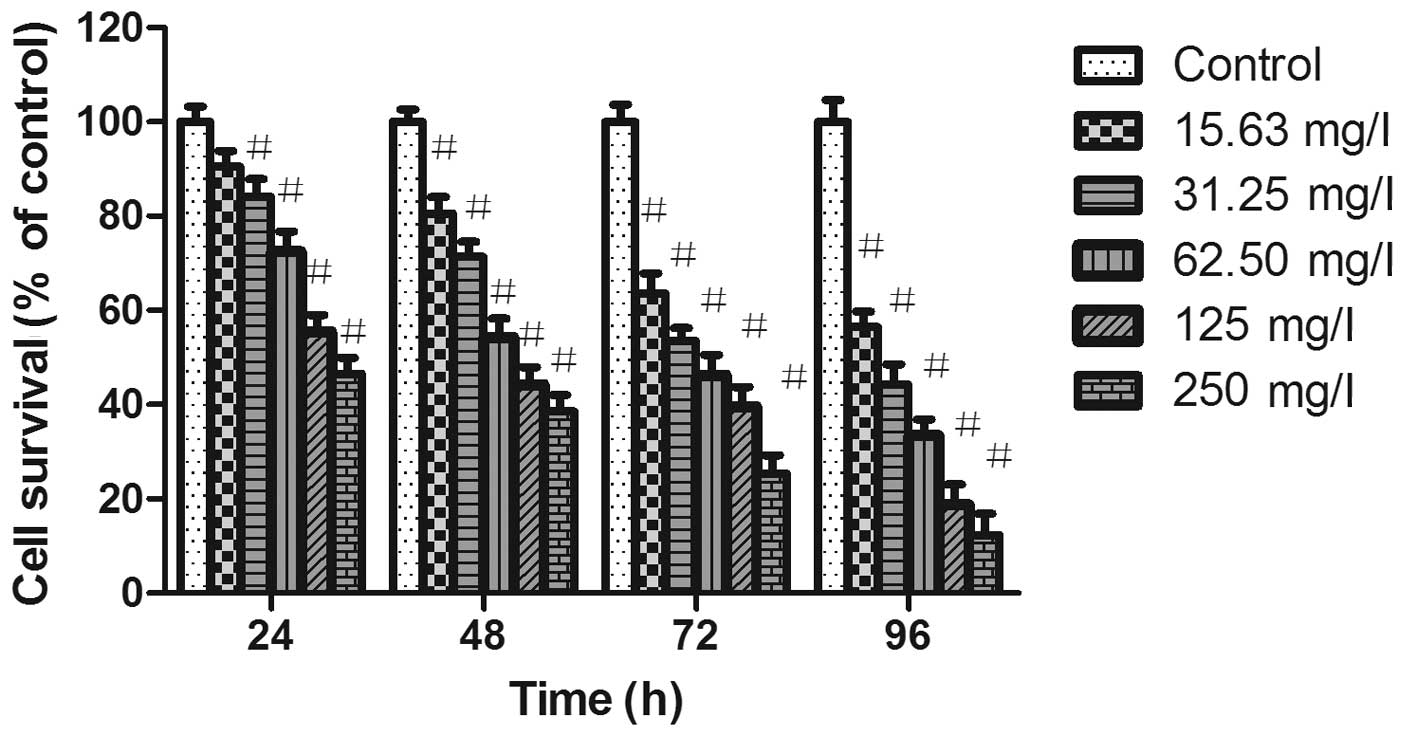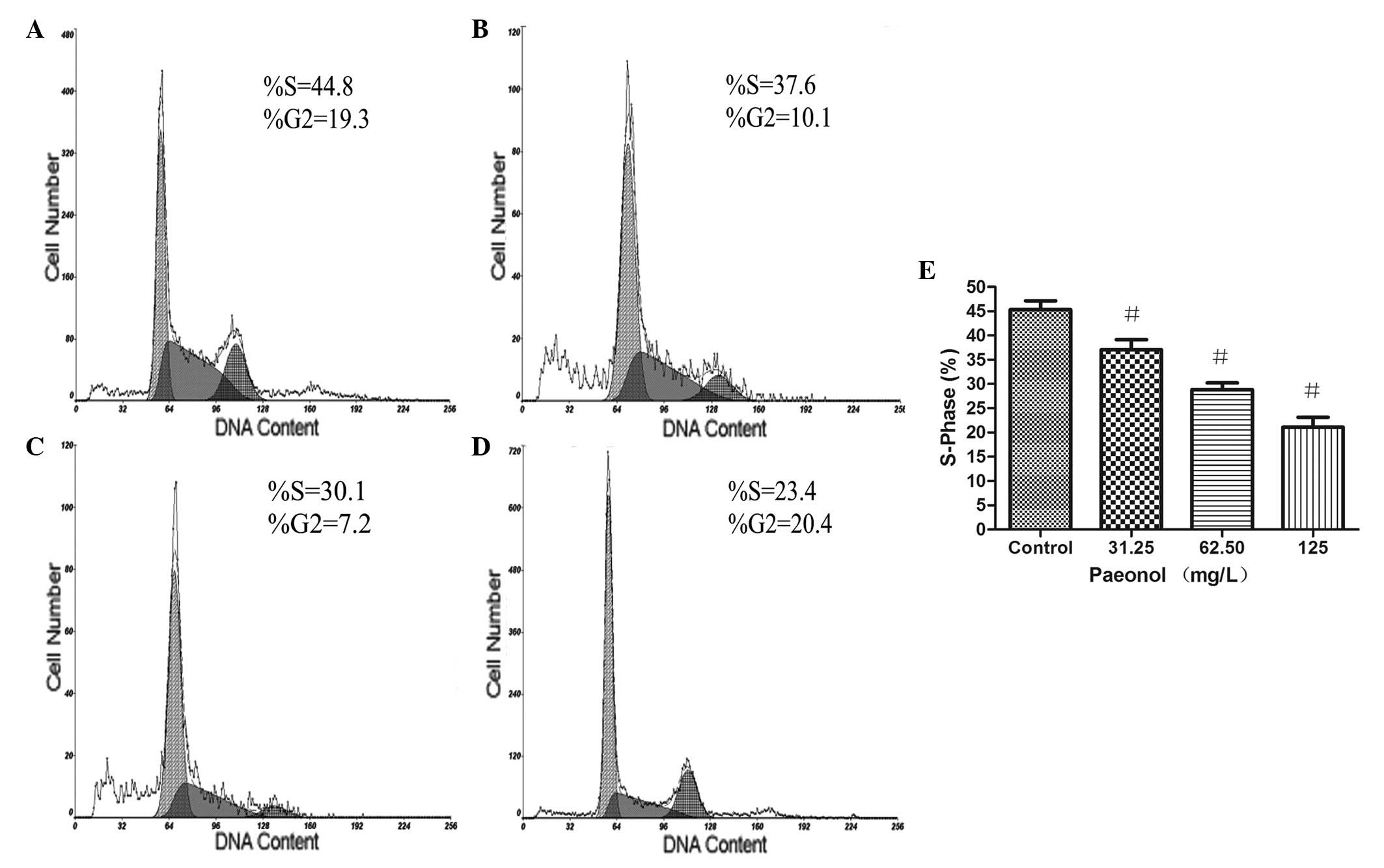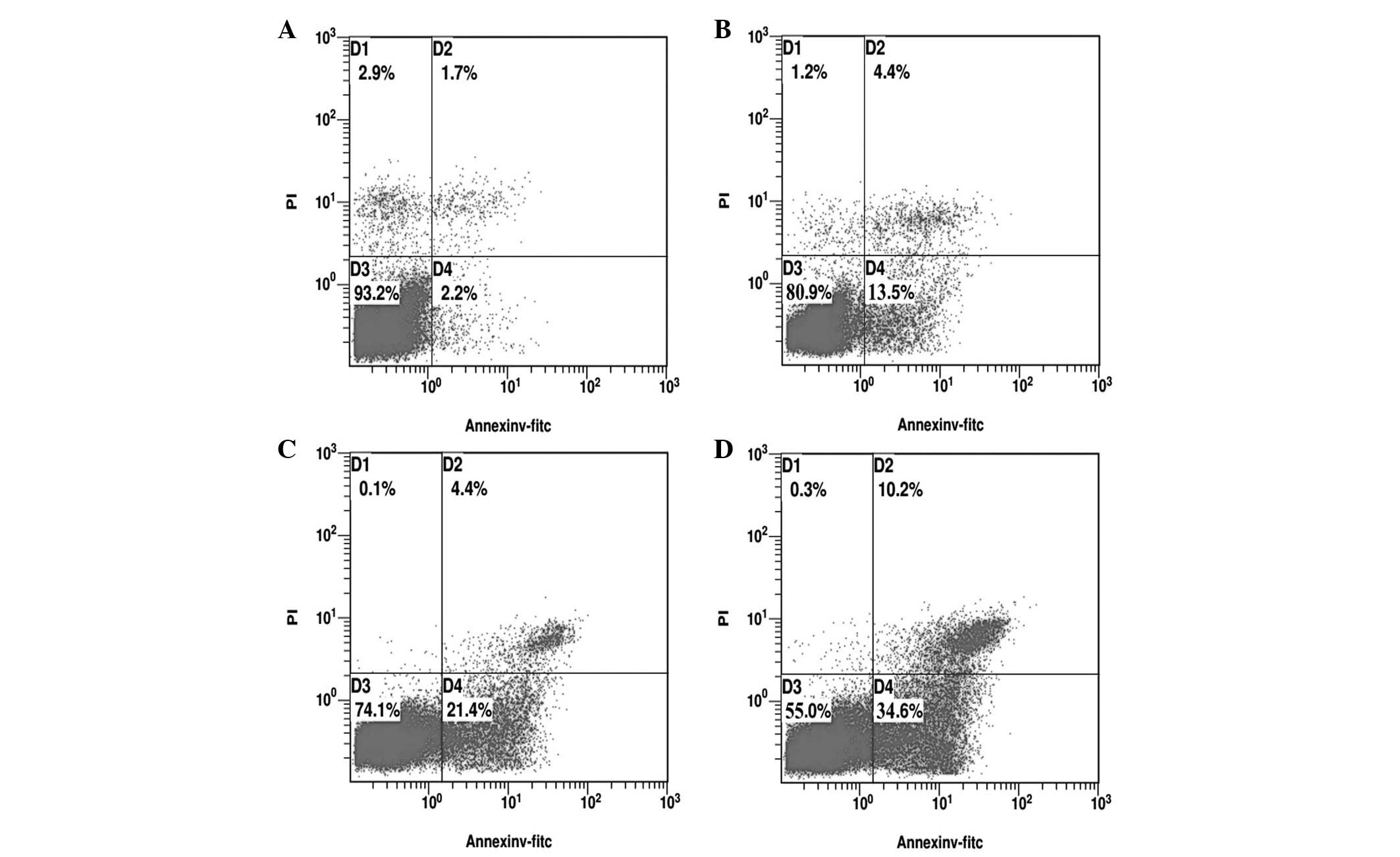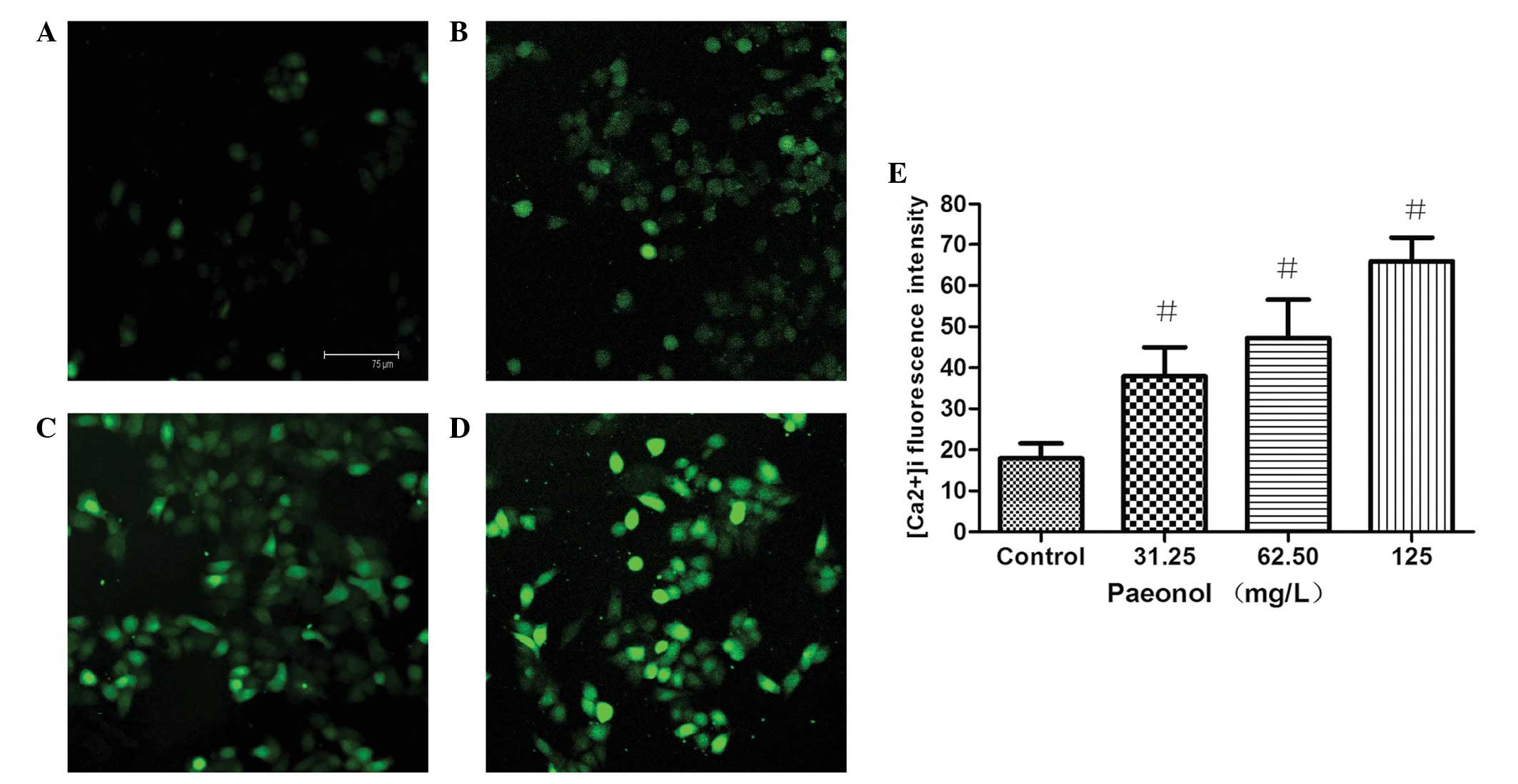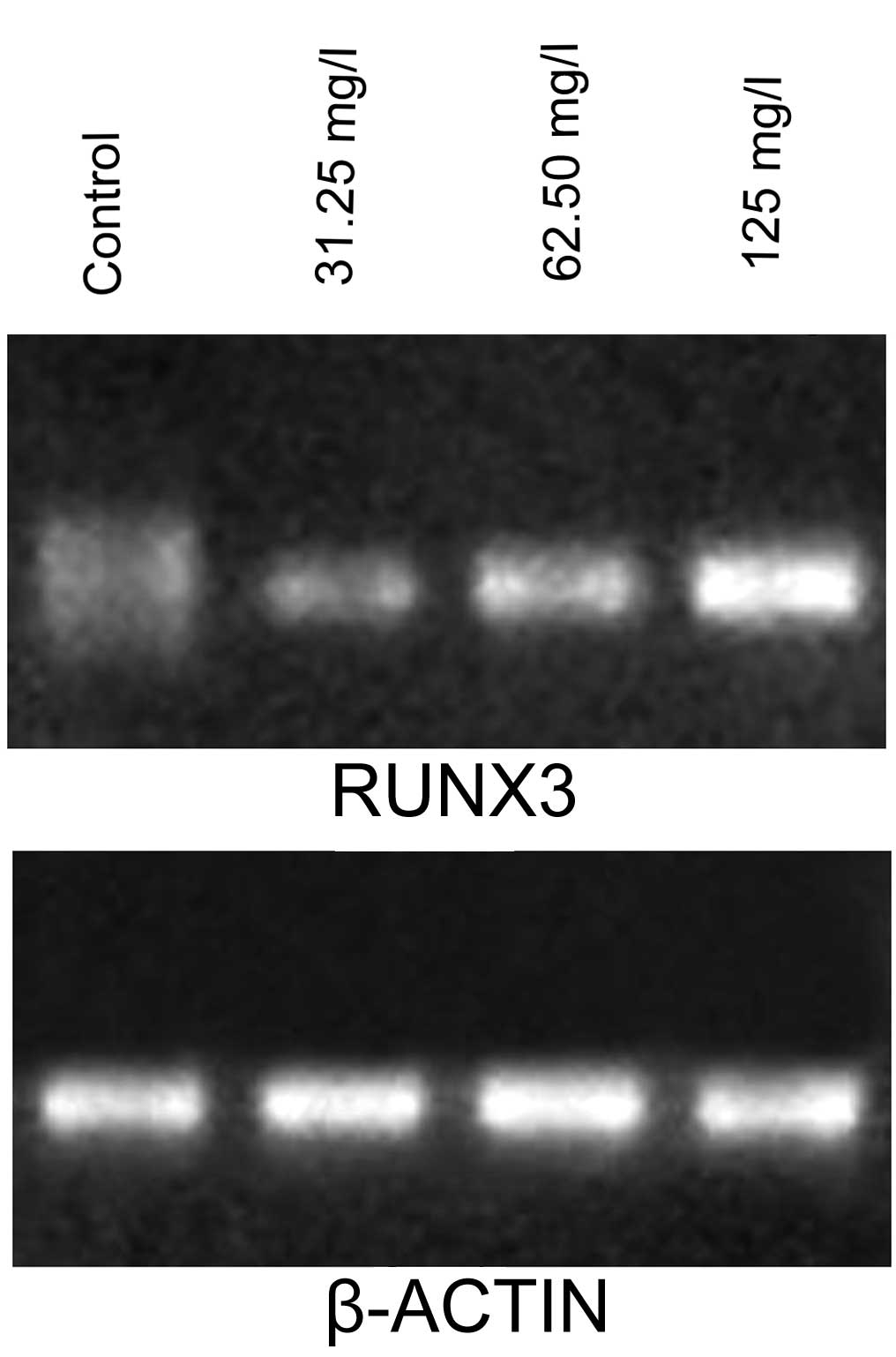Introduction
Cancer is the second leading cause of death in
industrialized countries. Colorectal cancer, a malignant tumor of
the digestive system, is the second most common cause of
cancer-related mortalities (1).
Surgical resection remains the main curative treatment. However,
with high rates of adjacent tissue invasion, metastasis and
recurrence, attempts to improve the outcomes of this disease have
incorporated the use of adjuvant chemotherapy. Cisplatin,
cyclophosphamide and 5-fluorouracil are chemotherapeutical drugs
utilized in cancer treatment. However, the development of drug
resistance and severe side effects of standard anticancer drugs
necessitates the identification of novel treatment strategies for
this disease. Therefore, the development of more effective and
low-toxicity chemotherapeutic agents is urgently required.
Paeonol (2-hydroxy-4-methoxyacetophenone), a major
active extract from the root bark of Paeonia suffruticosa
Andrews (2), possesses a number of
biological activities, including anti-inflammatory (3,4),
antioxidant (5), anti-angiogenic
(6), anti-allergic (7) and anti-oxidation (8). Previous studies have revealed that
paeonol exhibits antiproliferative effects and apoptosis-inducing
activities in various tumor cell lines in vitro and in
vivo(9–13). Our previous study demonstrated that
paeonol exhibited antineoplastic activity by promoting apoptosis in
the human colorectal carcinoma cell line, HT-29 (14). However, the underlying mechanisms
remain unknown. Therefore, in the present study, the effects of
paeonol on cell viability, intracellular calcium concentration and
the expression of runt-related transcription factor 3 (RUNX3) were
investigated in LoVo human colorectal cancer cells and the
antitumor mechanisms of paeonol were analyzed.
Materials and methods
Materials
Human colon cancer cell line, LoVo, was obtained
from the Cell Collection Center of Chinese Academy of Sciences
(Shanghai, China). Paeonol was purchased from Natura Pharmaceutical
Co., Ltd. (Zhejiang, China). RPMI-1640 medium, fetal bovine serum
(FBS), penicillin-streptomycin, pancreatin and glutamine were
purchased from Hangzhou Sijiqing Biological Engineering Materials
Co., Ltd. (Zhejiang, China). TRIzol total extraction kit was
purchased from Invitrogen Life Technologies (Carlsbad, CA, USA) and
the Annexin V-FITC/PI Apoptosis kit was purchased from Roche Ltd.
(Shanghai, China). Fluo-3/AM was obtained from Beyotime Institute
of Biotechnology (Suzhou, China), diluted to a suitable
concentration using DMSO, then separately loaded and stored
in the dark. All other chemicals were of reagent grade and obtained
from commercial sources. The study was approved by the ethics
committee of Renmin Hospital of Wuhan University, Wuhan, China.
Cell culture
Cells were incubated in RPMI-1640 medium
supplemented with 10% FBS, 2 mM L-glutamine and 1%
penicillin-streptomycin at 37°C in the presence of 5%
CO2; transfer of culture was performed once every 3–4
days. When the cells reached logarithmic growth, 0.25% pancreatin
was used to treat the cells for 2 min. The digested cells were
resuspended using RPMI-1640 medium containing 10% FBS and counted,
and the concentration of cells was adjusted to 1×104
cells/ml.
Cell proliferation assay
To evaluate the effect of paeonol on the
proliferation and viability of LoVo cells, cells were seeded at a
density of 5×103 cells/well containing 100 μl culture
medium in 96-well plates. Following 24 h cultivation, the medium
was replaced with fresh medium supplemented with various
concentrations of paeonol and further cultivated for the indicated
periods. Paeonol was added to the culture medium at a final
concentration of 15.63–250 mg/l. The control culture received only
the culture medium. Following further incubation, 10 μl WST-8
reagent was added to each well of a 96-well plate, followed by
incubation for 3 h at 37°C. The number of viable cells was
determined using the absorbance at 450 nm. The wells without
paeonol and the free cells (culture medium alone) were used as
blanks. Data are expressed as percentages of the controls.
Cell cycle analysis
Cell cycle status was determined by measuring
cellular DNA content following staining with propidium iodide using
flow cytometry. After treatment, the LoVo cells were centrifuged,
washed twice with ice-cold phosphate-buffered saline (PBS) and
fixed in 70% ethanol at 4°C for 24 h. Cells were then centrifuged
at 1,200 × g for 5 min and the supernatant was discarded. Pellets
were washed twice with 4 ml PBS and stained with 0.5 ml RNase A (2
mg/ml) and 0.5 ml propidium iodide (0.1% in 0.6% Triton-X in PBS)
for 30 min in the dark. The samples were then analyzed on a
FACSCalibur flow cytometer (Beckman Coulter, Inc., Fullerton, CA,
USA).
Cell apoptosis assay
To quantify apoptosis, cells were stained with
Annexin V and PI using the Annexin V-FITC/PI Apoptosis kit
according to the manufacturer’s instructions. Briefly, the cells
were washed twice with cold PBS following treatment and resuspended
in 195 μl Annexin V-FITC binding buffer. Annexin V-FITC (5 μl) was
added and mixed gently and the cells were incubated for 15 min at
room temperature in the dark. The cells were then centrifuged at
1,000 × g for 5 min and gently resuspended in 190 μl Annexin V-FITC
binding buffer. Following this, 10 μl propidium iodide staining
solution was added and gently mixed. The cells were kept on ice in
the dark and immediately subjected to flow cytometry. FCM Cell
Quest software was used to analyze the data.
Intracellular Ca2+ assay
After 48 h, LoVo cells treated with or without
paeonol were removed from the incubator. Culture solution in the
35-mm dishes was removed, the cells were rinsed 3 times with HEPES
and 4 μg/ml Fluo-3/AM (Beyotime Institute of Biotechnology) was
added (200 μl/dish). Next, the cells were incubated at 37°C for 60
min, followed by 3 washes with HEPES to discard the remaining
extracellular probe and 200 μl HEPES culture medium was used to
cover all cells in the troughs. Laser scanning confocal microscopy
(LSCM) was performed to observe the fluorescence intensity (FI) of
the cells, using an excitation wavelength of 488 nm and emission
wavelength of 555±15 nm.
RNA preparation and reverse transcription
polymerase chain reaction (RT-PCR)
Total RNA was isolated using TRIzol reagent and 1 μg
RNA was used as a template for the synthesis of cDNA using the
RevertAid First Strand cDNA Synthesis kit (Fermentas, Waltham, MA,
USA) according to the manufacturer’s instructions. PCR analysis was
performed in a final volume of 25 μl using PCR Master Mix
(Fermentas). Primer sequences were designed using Primer Premier 3
(Applied Biosystems, Carlsbad, CA, USA) and were as follows: RUNX3,
forward 5′-CAGAAGCTGGAGGACCAGAC-3′ and reverse
5′-TCGGAGAATGGGTTCAGTTC-3′; and β-actin, forward
5′-CACGATGGAGGGGCCGGACTCATC-3′ and reverse
5′-TAAAGACCTCTATGCCAACACAGT-3′. PCR products were separated in 1.5%
agarose gel, stained with ethidium bromide and images were
captured.
Statistical analysis
All continuous values are expressed as the mean ±
SD. Student’s t-test was used for comparison of the values between
two groups. SPSS 16.0 (SPSS Inc., Chicago, IL, USA) was used for
statistical analysis. P<0.05 was considered to indicate a
statistically significant difference.
Results
Effect of paeonol on proliferation in
human colon cancer LoVo cells
To determine the potential effect on cell growth,
LoVo cells were treated with increasing concentrations of paeonol
for various durations. The growth inhibition of LoVo cells was
determined using the WST-8 assay. The amount of yellow formazan dye
generated by dehydrogenase activity in the cells was directly
proportional to the number of living cells in the culture medium.
As demonstrated in Fig. 1, paeonol
significantly inhibited the proliferation of LoVo cells. The
viability of LoVo cells treated with paeonol decreased in a dose-
and time-dependent manner between 24 and 96 h incubation.
Effect of paeonol on the cell cycle in
human colon cancer LoVo cells
The G1/S transition is one of the two
main checkpoints that regulate cell cycle progression and thus cell
proliferation. In the present study, the effect of paeonol on the
G1 to S transition in LoVo cells was investigated via PI
staining followed by FACS analysis. As demonstrated in Fig. 2A and B, the percentage of S-phase
cells following treatment with 0, 31.25, 62.5 and 125 mg/l paeonol
was 45.37±2.9, 37.07±3.2, 28.87±2.4 and 21.10±3.4%, respectively
(P<0.05), indicating that paeonol inhibits LoVo cell
proliferation by blocking the cell cycle at the G1 to S
transition.
Effect of paeonol on cell apoptosis in
human colon cancer LoVo cells
Flow cytometry analysis was performed to analyze
apoptosis in LoVo cells treated with various concentrations of
paeonol for 48 h. As revealed in Fig.
3, the proportion of apoptotic cells increased from 12.4±2.1 to
35.1±3.7% in a dose-dependent manner. The percentage of apoptotic
cells treated with paeonol was significantly higher compared with
that in the control group (P<0.01), indicating that paeonol may
inhibit the growth of cultured LoVo cells by inducing
apoptosis.
Effect of paeonol on intracellular free
Ca2+ concentration ([Ca2+]i) in
human colon cancer LoVo cells
To explore whether paeonol-induced apoptosis is
associated with [Ca2+]i, the effect of
various concentrations of paeonol on [Ca2+]i
in LoVo cells was observed using LSCM after staining with the
fluorescent probe, Fluo-3/AM. As demonstrated in Fig. 4, images reveal
[Ca2+]i captured under a confocal microscope,
with the depth of the green color representing the FI, which
indirectly reflects [Ca2+]i. Control
[Ca2+]i was revealed to be extremely low,
while [Ca2+]i in all the paeonol-treated
groups (Fig. 4A-D) was increased
after 48 h, in a concentration-dependent manner. FI values,
obtained by LCSM, were consistent with these observations
(P<0.05; Fig. 4E). These
results indicate that paeonol induces a dose-dependent
[Ca2+]i influx and may induce the apoptosis
or necrosis that follows via calcium ion overload.
Effect of paeonol on expression of RUNX3
in human colon cancer LoVo cells
RUNX3 is known to play a tumor suppressive role in
various types of cancer. In particular, RUNX3 appears to be an
important component of the transforming growth factor-β
(TGF-β)-induced tumor suppression pathway. To elucidate the
interaction between RUNX3 and paeonol, LoVo cells were exposed to
0, 31.25, 62.5 or 125 mg/l paeonol for 48 h and the expression of
RUNX3 was detected, as demonstrated in Fig. 5. RUNX3 mRNA levels in cells treated
with 31.25 mg/l paeonol were observed to be higher than those in
the controls. Treatment with 125 mg/l paeonol led to a further
increase, indicative of a dose-dependent increase in RUNX3
expression.
Discussion
Apoptosis is a physiological process that controls
cell numbers and proliferation in order to maintain homeostasis in
multi-cellular organisms (15,16).
The balance between cell proliferation and apoptosis and cell cycle
distribution are extremely important factors during the process of
carcinogenesis in colon cancer (17). Apoptosis, a highly regulated death
process by which cells undergo inducible non-necrotic cellular
suicide, is vital for anti-carcinogenesis (18). Therefore, agents that facilitate
apoptosis are likely to improve therapeutic efficacy. In the
present study, paeonol was observed to inhibit the proliferation of
LoVo cells in a dose- and time-dependent manner (Fig. 1) and consistent results have been
observed in other cancer cell lines (data not shown). Analysis of
long-term cell viability also revealed that cytotoxicity levels
were altered in a dose-dependent manner. Results from flow
cytometry revealed that paeonol markedly decreased the percentage
of S-phase cells, indicating that paeonol may suppress cell growth
by blocking the cell cycle at the G1 to S transition,
which promotes apoptosis. To test this hypothesis, Annexin V/PI
staining was performed and the results demonstrated that paeonol
significantly induced apoptosis in LoVo cells (Fig. 3). Additionally, our previous study
showed that paeonol regulated the expression of Fas, Bcl-2, Bax and
p53, leading to the induction of apoptosis (14). These results indicated that paeonol
may inhibit the proliferation of cultured LoVo cells by activating
the apoptotic signaling pathway.
In addition, the underlying mechanisms of apoptosis
induction in LoVo cells were investigated. The
[Ca2+]i in LoVo cells was observed to be
significantly increased when cells were cultured with paeonol at
31.25–125 mg/l (Fig. 4).
Ca2+ ions are crucial in a number of physiological and
pathological processes for the majority of cell types (19). A rise in
[Ca2+]i is associated with various cellular
functions, including proliferation, division, fertilization,
movement and apoptosis (20). It
has been reported that increases in cytosolic Ca2+
concentrations occur at the early and late stages of the apoptotic
pathway (21,22). Ca2+ overload has also
been hypothesized to be the final common pathway for all types of
cell death. In the present study, fluorescence microscopy revealed
that the [Ca2+]i FI of cells loaded with
Fluo-3/AM in the control group was extremely low, while that in all
the paeonol-treated groups was markedly increased in a
dose-dependent manner. These results indicate that paeonol-induced
increases in [Ca2+]i play a pivotal role in
eliciting early signals for triggering apoptosis.
Additionally, in the present study, paeonol was
shown to promote the expression of RUNX3 in LoVo cells in a
dose-dependent manner (P<0.05). RUNX3 (chromosome 1p36.1)
belongs to the RUNX family of transcription factors (23) and has been reported to function as
a tumor suppressor in various forms of cancer. RUNX3 is an
important target of the TGF-β signaling pathway (24) and an inhibitor of the Wnt pathway
(25,26). Previous studies have revealed that
the central role of RUNX3 in tumor formation may be associated with
its developmental significance (27,28).
The major reason for the lost or decreased expression of RUNX3 is
hypermethylation of the RUNX3 proximal promoter CpG island, which
is involved in the formation of a number of cancer types, including
breast (29), gastric (30,31)
and colon cancer (32,33). The restoration of RUNX3 has been
revealed to result in the marked suppression of tumor growth and
metastasis by inducing cell cycle arrest, apoptosis and the
downregulation of cyclinD1 expression in gastric cancer cell lines
(34,35). In the current study, paeonol was
shown to significantly upregulate the expression of RUNX3 in LoVo
cells. FACS analysis indicated that paeonol blocked the cell cycle
at the G1 to S transition. Flow cytometry revealed that
paeonol significantly induced apoptosis in LoVo cells. These
results indicate that paeonol induces apoptosis by promoting the
expression of RUNX3, which blocks the cell cycle at the
G1 to S transition and thus interferes with DNA
synthesis.
In addition to increasing
[Ca2+]i, paeonol was shown to simultaneously
upregulate the expression of RUNX3, indicating that these processes
may be associated with the same apoptotic pathway. It has been
reported that a rise in [Ca2+]i is important
for various biological responses, including gene transcription and
apoptosis (36). The restoration
of Runx3, a tumor suppressor, may inhibit tumor growth and
metastasis by the induction of cell cycle arrest and apoptosis. In
the present study, [Ca2+]i and the expression
of RUNX3 were demonstrated to be positively correlated following
paeonol treatment. Consequently, we hypothesized that
[Ca2+]i and RUNX3 may cooperate in inhibiting
the proliferation of colorectal carcinoma cells and promoting
apoptosis. More specifically, increased
[Ca2+]i causes apoptosis and the upregulation
of RUNX3, and RUNX3 induces apoptosis and thus increases
[Ca2+]i.
Based on results of the present study, paeonol
exhibits a marked antitumor effect and one of the antitumor
mechanisms of paeonol may be associated with apoptosis induction by
increased [Ca2+]i and the upregulation of
RUNX3 expression. Additional studies are required to investigate
the apoptotic mechanism of paeonol and its suitability as a novel
strategy for the therapy of colon carcinoma.
Acknowledgements
The present study was supported by grants from the
Natural Science Foundation of Hubei Province (no. 2010CDB06908),
Wuhan Science and Technology Bureau Fund (no. 201060938363-05) and
the Fundamental Research Funds for the Central Universities (no.
201130202020017).
References
|
1
|
Strimpakos AS, Cunningham D, Mikropoulos
C, Petkar I, Barbachano Y and Chau I: The impact of
carcinoembryonic antigen flare in patients with advanced colorectal
cancer receiving first-line chemotherapy. Ann Oncol. 21:1013–1019.
2010. View Article : Google Scholar : PubMed/NCBI
|
|
2
|
Riley CM and Ren TC: Simple method for the
determination of paeonol in human and rabbit plasma by
high-performance liquid chromatography using solid-phase extraction
and ultraviolet detection. J Chromatogr. 489:432–437. 1989.
View Article : Google Scholar
|
|
3
|
Chou TC: Anti-inflammatory and analgesic
effects of paeonol in carrageenan-evoked thermal hyperalgesia. Br J
Pharmacol. 139:1146–1152. 2003. View Article : Google Scholar : PubMed/NCBI
|
|
4
|
Huang H, Chang EJ, Lee Y, Kim JS, Kang SS
and Kim HH: A genome-wide microarray analysis reveals
anti-inflammatory target genes of paeonol in macrophages. Inflamm
Res. 57:189–198. 2008. View Article : Google Scholar : PubMed/NCBI
|
|
5
|
Hsieh CL, Cheng CY, Tsai TH, Lin IH, Liu
CH, Chiang SY, Lin JG, Lao CJ and Tang NY: Paeonol reduced cerebral
infarction involving the superoxide anion and microglia activation
in ischemia-reperfusion injured rats. J Ethnopharmacol.
106:208–215. 2006. View Article : Google Scholar : PubMed/NCBI
|
|
6
|
Kim SA, Lee HJ, Ahn KS, Lee HJ, Lee EO,
Ahn KS, Choi SH, Jung SJ, Kim JY, Baek N and Kim SH: Paeonol exerts
anti-angiogenic and anti-metastatic activities through
downmodulation of Akt activation and inactivation of matrix
metalloproteinases. Biol Pharm Bull. 32:1142–1147. 2009. View Article : Google Scholar : PubMed/NCBI
|
|
7
|
Kim SH, Kim SA, Park MK, Kim SH, Park YD,
Na HJ, Kim HM, Shin MK and Ahn KS: Paeonol inhibits anaphylactic
reaction by regulating histamine and TNF-alpha. Int
Immunopharmacol. 4:279–287. 2004. View Article : Google Scholar : PubMed/NCBI
|
|
8
|
Sun YC, Shen YX and Sun GP: Advances in
the studies of major pharmacological activity of paeonol. Zhong
Cheng Yao Zazhi. 26:579–582. 2004.(In Chinese).
|
|
9
|
Chen B, Ning M and Yang G: Effect of
paeonol on antioxidant and immune regulatory activity in
hepatocellular carcinoma rats. Molecules. 17:4672–4683. 2012.
View Article : Google Scholar : PubMed/NCBI
|
|
10
|
Li N, Fan LL, Sun GP, Wan XA, Wang ZG, Wu
Q and Wang H: Paeonol inhibits tumor growth in gastric cancer in
vitro and in vivo. World J Gastroenterol. 16:4483–4490. 2010.
View Article : Google Scholar : PubMed/NCBI
|
|
11
|
Lee HJ, Kim SA, Lee HJ, Jeong SJ, Han I,
Jung JH, Lee EO, Zhu S, Chen CY and Kim SH: Paeonol oxime inhibits
bFGF-induced angiogenesis and reduces VEGF levels in fibrosarcoma
cells. PLoS One. 5:e123582010. View Article : Google Scholar : PubMed/NCBI
|
|
12
|
Wan XA, Sun GP, Wang H, Xu SP, Wang ZG and
Liu SH: Synergistic effect of paeonol and cisplatin on oesophageal
cancer cell lines. Dig Liver Dis. 40:531–539. 2008. View Article : Google Scholar : PubMed/NCBI
|
|
13
|
Xing G, Zhang Z, Liu J, Hu H and Suqiura
N: Antitumor effect of extracts from moutan cortex on DLD-1 human
colon cancer cells in vitro. Mol Med Rep. 3:57–61. 2010.PubMed/NCBI
|
|
14
|
Ye JM, Deng T and Zhang JB: Influence of
paeonol on expression of COX-2 and p27 in HT-29 cells. World J
Gastroenterol. 15:4410–4414. 2009. View Article : Google Scholar : PubMed/NCBI
|
|
15
|
LaCasse EC, Mahoney DJ, Cheung HH,
Plenchette S, Baird S and Korneluk RG: IAP-targeted therapies for
cancer. Oncogene. 27:6252–6275. 2008. View Article : Google Scholar : PubMed/NCBI
|
|
16
|
Wang S: The promise of cancer therapeutics
targeting the TNF-related apoptosis-inducing ligand and TRAIL
receptor pathway. Oncogene. 27:6207–6215. 2008. View Article : Google Scholar : PubMed/NCBI
|
|
17
|
Huang WS, Wang JP, Wang T, Fang JY, Lan P
and Ma JP: ShRNA-mediated gene silencing of beta-catenin inhibits
growth of human colon cancer cells. World J Gastroenterol.
13:6581–6587. 2007. View Article : Google Scholar : PubMed/NCBI
|
|
18
|
Kaufmann SH and Hengartner MO: Programmed
cell death: alive and well in the new millennium. Trends Cell Biol.
11:526–534. 2001. View Article : Google Scholar : PubMed/NCBI
|
|
19
|
Clapham DE: Intracellular calcium.
Replenishing the stores. Nature. 375:634–635. 1995. View Article : Google Scholar : PubMed/NCBI
|
|
20
|
Bootman MD, Berridge MJ and Roderick HL:
Calcium signalling: more messengers, more channels, more
complexity. Curr Biol. 12:R563–R565. 2002. View Article : Google Scholar : PubMed/NCBI
|
|
21
|
Kruman I, Guo Q and Mattson MP: Calcium
and reactive oxygen species mediate staurosporine-induced
mitochondrial dysfunction and apoptosis in PC12 cells. J Neurosci
Res. 51:293–308. 1998. View Article : Google Scholar : PubMed/NCBI
|
|
22
|
Martikainen P, Kyprianou N, Tucker RW and
Isaacs JT: Programmed death of nonproliferating
androgen-independent prostatic cancer cells. Cancer Res.
51:4693–4700. 1991.PubMed/NCBI
|
|
23
|
Bangsow C, Rubins N, Glusman G, Bernstein
Y, Negreanu V, Goldenberg D, Lotem J, Ben-Asher E, Lancet D,
Levanon D and Groner Y: The RUNX3 gene - sequence, structure and
regulated expression. Gene. 279:221–232. 2001. View Article : Google Scholar : PubMed/NCBI
|
|
24
|
Subramaniam MM, Chan JY, Yeoh KG, Quek T,
Ito K and Salto-Tellez M: Molecular pathology of RUNX3 in human
carcinogenesis. Biochim Biophys Acta. 1796:315–331. 2009.PubMed/NCBI
|
|
25
|
Ito K, Lim AC, Salto-Tellez M, Motoda L,
Osato M, Chuang LS, Lee CW, Voon DC, Koo JK, Wang H, Fukamachi H
and Ito Y: RUNX3 attenuates beta-catenin/T cell factors in
intestinal tumorigenesis. Cancer Cell. 14:226–237. 2008. View Article : Google Scholar : PubMed/NCBI
|
|
26
|
Licchesi JD, Westra WH, Hooker CM, Machida
EO, Baylin SB and Herman JG: Epigenetic alteration of Wnt pathway
antagonists in progressive glandular neoplasia of the lung.
Carcinogenesis. 29:895–904. 2008. View Article : Google Scholar : PubMed/NCBI
|
|
27
|
Lee JM, Kwon HJ, Bae SC and Jung HS: Lung
tissue regeneration after induced injury in Runx3 KO mice. Cell
Tissue Res. 341:465–470. 2010. View Article : Google Scholar : PubMed/NCBI
|
|
28
|
Lee KS, Lee YS, Lee JM, Ito K, Cinghu S,
Kim JH, Jang JW, Li YH, Goh YM, Chi XZ, Wee H, Lee HW, Hosoya A,
Chung JH, Jang JJ, Kundu JK, Surh YJ, Kim WJ, Ito Y, Jung HS and
Bae SC: Runx3 is required for the differentiation of lung
epithelial cells and suppression of lung cancer. Oncogene.
29:3349–3361. 2010. View Article : Google Scholar : PubMed/NCBI
|
|
29
|
Subramaniam MM, Chan JY, Soong R, Ito K,
Ito Y, Yeoh KG, Salto-Tellez M and Putti TC: RUNX3 inactivation by
frequent promoter hypermethylation and protein mislocalization
constitute an early event in breast cancer progression. Breast
Cancer Res Treat. 113:113–121. 2009. View Article : Google Scholar
|
|
30
|
Ito K, Liu Q, Salto-Tellez M, Yano T, Tada
K, Ida H, Huang C, Shah N, Inoue M, Rajnakova A, Hiong KC, Peh BK,
Han HC, Ito T, Teh M, Yeoh KG and Ito Y: RUNX 3, a novel tumor
suppressor, is frequently inactivated in gastric cancer by protein
mislocalization. Cancer Res. 65:7743–7750. 2005.PubMed/NCBI
|
|
31
|
Li QL, Ito K, Sakakura C, Fukamachi H,
Inoue KI, Chi XZ, Lee KY, Nomura S, Lee CW, Han SB, Kim HM, Kim WJ,
Yamamoto H, Yamashita N, Yano T, Ikeda T, Itohara S, Inazawa J, Abe
T, Hagiwara A, Yamagishi H, Ooe A, Kaneda A, Sugimura T, Ushijima
T, Bae SC and Ito Y: Causal relationship between the loss of RUNX3
expression and gastric cancer. Cell. 109:113–124. 2002. View Article : Google Scholar : PubMed/NCBI
|
|
32
|
Ahlquist T, Lind GE, Costa VL, Meling GI,
Vatn M, Hoff GS, Rognum TO, Skotheim RI, Thiis-Evensen E and Lothe
RA: Gene methylation profiles of normal mucosa and benign and
malignant colorectal tumors identify early onset markers. Mol
Cancer. 7:942008. View Article : Google Scholar : PubMed/NCBI
|
|
33
|
Subramaniam MM, Chan JY, Soong R, Ito K,
Yeoh KG, Wong R, Guenther T, Will O, Chen CL, Kumarasinghe MP, Ito
Y and Salto-Tellez M: RUNX3 inactivation in colorectal polyps
arising through different pathways of colonic carcinogenesis. Am J
Gastroenterol. 104:426–436. 2009. View Article : Google Scholar : PubMed/NCBI
|
|
34
|
Chi XZ, Yang JO, Lee KY, Ito K, Sakakura
C, Li QL, Kim HR, Cha EJ, Kaneda A, Ushijima T, Kim WJ, Ito Y and
Bae SC: RUNX3 suppresses gastric epithelial cell growth by inducing
p21WAF1/Cip1 expression in cooperation with transforming
growth factor β-activated SMAD. Mol Cell Biol. 25:8097–8107. 2005.
View Article : Google Scholar : PubMed/NCBI
|
|
35
|
Wei D, Gong W, Oh SC, Li Q, Kim WD, Wang
L, Le X, Yao J, Wu TT, Huang S and Xie K: Loss of RUNX3 expression
significantly affects the clinical outcome of gastric cancer
patients and its restoration causes drastic suppression of tumor
growth and metastasis. Cancer Res. 65:4809–4816. 2005. View Article : Google Scholar
|
|
36
|
Müller I, Lipp P and Thiel G:
Ca2+ signaling and gene transcription in
glucose-stimulated insulinoma cells. Cell Calcium. 52:137–151.
2012.
|















